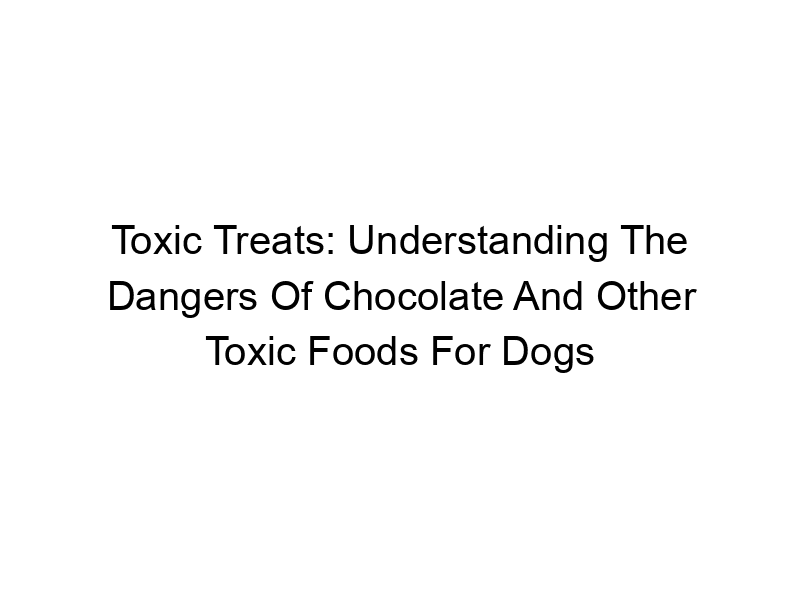Is your furry friend a secret snack thief? Do you worry about what they might be getting into? This comprehensive guide explores the dangers of chocolate and other toxic foods for dogs, offering crucial information to protect your beloved canine companion. We’ll delve into the specifics of chocolate toxicity, explore other harmful foods, discuss the symptoms of poisoning, and provide advice on preventing accidents. You’ll learn how to identify potentially dangerous substances, understand the severity of various toxins, and know what to do in an emergency. Let’s keep our dogs safe and happy!
Chocolate’s danger lies in theobromine, a compound similar to caffeine. Dogs metabolize theobromine much slower than humans, leading to a build-up that can cause serious health problems. The darker and more bitter the chocolate, the higher
the theobromine concentration, making dark chocolate far more dangerous than milk chocolate. Even small amounts of baking chocolate can be lethal.
Symptoms of Chocolate Poisoning
Symptoms can vary depending on the amount ingested and the type of chocolate. Mild cases may show restlessness and hyperactivity, while severe cases can lead to vomiting, diarrhea, tremors, seizures, and even heart failure. Early recognition of symptoms is vital for prompt veterinary intervention.
Treating Chocolate Toxicity
Treatment typically involves inducing vomiting or administering activated charcoal to absorb the theobromine. Intravenous fluids may be necessary to counteract dehydration. The prognosis depends on the severity of poisoning and the speed of treatment. Immediate veterinary attention is crucial.
Other Toxic Foods for Dogs
Xylitol: A Hidden Danger
Xylitol, an artificial sweetener found in many sugar-free products (gum, candy, toothpaste), is extremely toxic to dogs. Even small amounts can cause a rapid drop in blood sugar, leading to liver failure. Symptoms include weakness, lethargy, and seizures. Immediate veterinary care is essential.
Grapes and Raisins: Renal Failure Risk
Grapes and raisins are another surprising culprit. The toxic component remains unknown, but ingestion can cause acute kidney failure. Symptoms can range from vomiting and diarrhea to lethargy and decreased urination. Veterinary care is critical.
Onions and Garlic: Hemolytic Anemia
Onions and garlic contain compounds that damage red blood cells, leading to hemolytic anemia. Symptoms include weakness, pale gums, and rapid breathing. Severe cases can be fatal.
Macadamia Nuts: Neurotoxicity
Macadamia nuts contain unknown toxins that affect a dog’s nervous system. Symptoms include weakness, tremors, hyperthermia, and vomiting. The effects are usually temporary, but veterinary attention is recommended.
Avocado: Persin Toxicity
Avocados contain persin, a toxin that can cause vomiting and diarrhea in dogs. The pit and skin contain the highest concentration of persin.
Alcohol: Central Nervous System Depression
Even small amounts of alcohol can cause severe intoxication in dogs, leading to central nervous system depression. Symptoms include incoordination, vomiting, and difficulty breathing. Immediate veterinary care is needed.
Yeast Dough: Bloating and Gas Production
Yeast dough expands in a dog’s stomach, causing severe bloating and gas production. This can lead to stomach torsion (twisting), a life-threatening condition requiring emergency surgery.
Caffeine: Similar Effects to Chocolate
Caffeine, like theobromine, is a stimulant that can be toxic to dogs. Coffee grounds, tea leaves, and energy drinks should be kept out of reach.
Cooked Bones: Choking and Internal Injuries
Cooked bones splinter easily, posing a choking hazard and causing internal injuries. Raw bones are generally safer, but supervision is still necessary.
Artificial Sweeteners: Beyond Xylitol
Several artificial sweeteners beyond xylitol can be harmful. Always check labels carefully and keep all artificial sweeteners out of your dog’s reach.
Milk and Dairy Products: Lactose Intolerance
Many dogs are lactose intolerant and can experience digestive upset after consuming milk or dairy products. Symptoms include diarrhea, gas, and vomiting.
Preventing Toxic Food Exposures
Secure Food Storage
Store all potentially harmful foods securely, out of your dog’s reach. Use sealed containers and keep countertops clean.
Supervise Feeding
Always supervise your dog while they are eating, especially if they tend to be opportunistic eaters.
Educate Family Members
Make sure all family members and visitors understand the dangers of certain foods for dogs.
Training and Obedience
Train your dog to leave food items alone. Positive reinforcement techniques are more effective than punishment.
Identifying and Responding to Poisoning
Recognizing Symptoms
Learn to recognize the symptoms of poisoning in dogs, including vomiting, diarrhea, lethargy, tremors, and seizures.
Emergency Veterinary Care
If you suspect your dog has ingested a toxic substance, contact your veterinarian or an animal poison control center immediately.
Frequently Asked Questions
What are the most common toxic foods for dogs?
Chocolate, xylitol, grapes, raisins, onions, garlic, and macadamia nuts are among the most common toxic foods for dogs.
How much chocolate is toxic to a dog?
The amount of chocolate that’s toxic varies depending on the type of chocolate and the dog’s size. Dark chocolate is the most dangerous. Even small amounts can be harmful to small dogs.
What are the symptoms of xylitol poisoning in dogs?
Xylitol poisoning symptoms include weakness, lethargy, seizures, and low blood sugar. Immediate veterinary attention is crucial.
What should I do if my dog eats something toxic?
Contact your veterinarian or an animal poison control center immediately. Try to determine what your dog ate and how much. Do not induce vomiting unless instructed by a professional.
Are all nuts toxic to dogs?
Macadamia nuts are particularly toxic. Other nuts, such as walnuts and pecans, can also cause digestive upset.
How can I prevent my dog from eating toxic foods?
Secure food storage, supervise feeding, educate family members, and train your dog to leave food alone.
What is the prognosis for a dog that has ingested a toxic substance?
The prognosis depends on several factors, including the type and amount of toxin ingested, the dog’s size and overall health, and the promptness of treatment. Early intervention greatly improves the chances of a full recovery.
Final Thoughts
Protecting your dog from toxic foods requires vigilance and proactive measures. Understanding the dangers of chocolate and other harmful substances, coupled with responsible food storage and supervision, is crucial for ensuring your furry friend’s well-being. By being aware of the risks and taking preventative steps, you can contribute significantly to your dog’s long, healthy, and happy life. Remember, if you suspect your dog has ingested something toxic, don’t hesitate – contact your veterinarian or an animal poison control center immediately. Their expertise can make all the difference in a potentially life-threatening situation.




